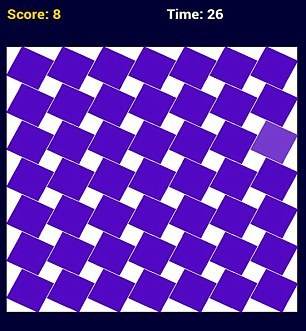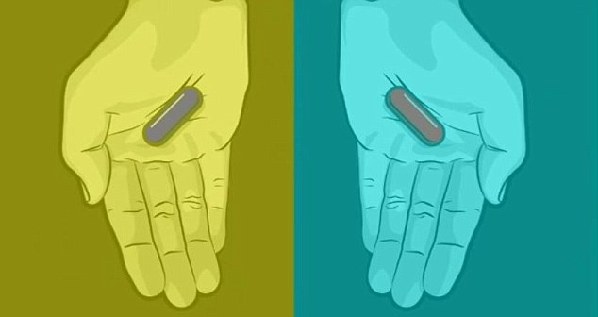當(dāng)前位置: Language Tips> 雙語新聞
How good is YOUR colour vision?
分享到

The latest app that's sweeping the web is the fiendishly addictive, and surprisingly difficult, Kuku Kube.
最新顏色辨識應(yīng)用程序Kuku Kube正在席卷網(wǎng)絡(luò),它像惡魔般使人上癮,并且難度驚人。
It has been designed to put your colour vision and eyesight to the test by showing boards of coloured squares.
這個游戲在測試中展示由彩色色塊組成的多個板塊,是一個測試色覺和視力的游戲。
On each board, one of the squares is a slightly different shade of the same colour and the aim is to find this odd square by tapping it with your finger or clicking it with the mouse.
在每個同色的板塊中,有一個色塊相比其他相同的色塊顏色略微淺,而游戲的目標(biāo)就是用手指敲擊或者用鼠標(biāo)點擊去找出這個不一樣的方塊。
Although the game appears relatively simple, and starts with a board of just four coloured squares, it quickly grows to a board of up to 81 squares.
盡管這個游戲看起來相對簡單,而且在開始僅僅有四個彩色色塊,但是很快,它就增長到高達八十一個的色塊。
And the differentiation between the shades becomes more subtle over time.
而顏色間細(xì)微的差別也隨著時間的推移變得更加微妙。
Players get a point for every correct square identified, but if they click or tap the wrong square they lose a point.
玩家識別出一個正確色塊,就可得到一分,但如果點擊了錯誤的色塊,就會失去一分。
Plus, players get just 60 seconds to find the odd square on each board before the timer runs out and the game ends.
另外,玩家只有60秒的時間,玩家需要在計時器停止、游戲結(jié)束之前找到每個不一樣的色塊。
It was created by Canada-based Network365 and is available for free on Facebook, Android, iOS and on desktop browsers.
它是由加拿大Network365公司創(chuàng)建,F(xiàn)acebook、安卓、iOS和桌面瀏覽器上免費提供此游戲。
There are eight levels, and as a player progresses the squares change orientation or add borders to make it harder.
它設(shè)有八級,且伴隨著玩家的升級,它的色塊會改變方位并增多板塊以加大難度。
On the desktop version the game lets you continue until the timer runs out, but on mobile apps players can't progress until they have scored more than 20 points on each level.
桌面版本的游戲可以讓你在計時器停止前繼續(xù)玩下去,但手機應(yīng)用程序的玩家,在每個級別超過二十分之前,不能玩下一關(guān)。
The app makers said scores lower than 11 are poor, scores between 15 and 20 is 'lower than average', 21 to 30 is considered normal or average, and a score higher than 31 means your eyesight is 'great.'
該應(yīng)用程序創(chuàng)造者表示,分?jǐn)?shù)低于十一的人色覺比較差,分?jǐn)?shù)介于十五至二十分的玩家則“低于平均水平”,二十一至三十的玩家被認(rèn)為是正常或一般,而得分比三十一高意味著你的視力“非常好”。
'This puzzle is designed to evaluate the quality of your colour vision,' said the developers.
“這個游戲是為了評估你的色覺,”開發(fā)者稱。
'You should identify the difference, if possible, and share your result with your friends.'
“你應(yīng)該找出差異,如果可能的話,還可與你的朋友分享你的結(jié)果。”
But they stressed: 'Even though this test can be very accurate, it should never be used to replace a doctor's visit.
但他們強調(diào):“雖然這個測試非常準(zhǔn)確,但是它不應(yīng)該被用來代替醫(yī)生的問診。”
'[It] provides basic information and guideline for your eyesight and colour test, and is not intended to replace a full or partial eye examination.'
“它為你的視力和色彩測試提供基本的信息和指南,但不是為了取代全面或部分的眼科檢查。”
Eyesight and colour was recently linked to how we perceive the world by Michael Abrash, chief scientist from Facebook-owned virtual reality (VR) experts Oculus.
Facebook旗下的虛擬現(xiàn)實(VR)專家Oculus公司的首席科學(xué)家Michael Abrash,提出了視覺與色彩近來被聯(lián)系到我們?nèi)绾胃兄澜纭?/p>
He explained that humans only have three colour sensors, we can’t see infrared or ultraviolet and we have a blind spot in each eye.
他解釋說,人類只有三種顏色感應(yīng)器官,我們無法看到的紅外線或紫外線,而且我們的每只眼睛都有盲點。
‘Our visual data is actually astonishingly sparse and even if we were able to accurately record and process every photon that reaches our eyes, we’d still have too little data to be able to reconstruct the world accurately,' he said.
“實際上,我們的視覺數(shù)據(jù)的不足是驚人的,即使我們能夠準(zhǔn)確地記錄和處理每一個到達我們眼睛的光子,能夠準(zhǔn)確地復(fù)原世界的數(shù)據(jù)對我們來說還是太少。”他說。
He used the recent black and blue/white and gold dress as an example.
他用了最近裙子是藍(lán)黑還是白金的問題作為例子。
‘Our visual system takes its best guess and sends that to the conscious mind,’ he continued.
“我們的視覺系統(tǒng)選用并發(fā)送最佳猜測至我們的意識,”他繼續(xù)說。
'The way that the brain compensates for the limited data it receives is by maintaining a model of the real world that it constantly updates as new data comes in.
“大腦為了補償其接收信息的有限,在每次有新的數(shù)據(jù)輸入時,不斷更新以維護在腦中反應(yīng)現(xiàn)實世界的模型。”
'And it is that model, not the real world, that you experience and trust implicitly. We are inference machines, not objective observers.
“而這只是你所感受到的和完全信任的模型,而不是真正的現(xiàn)實世界。我們是一個干預(yù)機器,而不是客觀的觀察者。 ”
He then showed a red and blue pill on hands that were shown on a yellow background to give an example of how this inference model breaks down.
為了舉出一個能夠證明這個推論模型是如何失效的實例,他隨即在手上展示了一個之前被展示在一個黃色的背景下的“紅色和藍(lán)色”的藥片。
The colours of the pills are the same shade of grey, and the red and blue colours that people see are simply what their brains perceive, based on the rest of the information around them.
這兩個藥片都是一樣的灰色,而人們看到的紅色和藍(lán)色僅僅是他們的大腦感知,這基于他們周圍其余的信息。
And even when a person knows that the pills are grey, they still see them as red or blue.
而且甚至當(dāng)一個人知道藥丸是灰色的時候,他們?nèi)匀徽J(rèn)為他們看見的是紅色或藍(lán)色。
‘Your visual system isn’t interested in whether the photon coming from a tile on a random image are red or blue or grey,' Mr Abrash continued.
“你的視覺系統(tǒng)對一個來自隨機圖像的光子到底是紅色或藍(lán)色或灰色的并不感興趣,”Abrash先生繼續(xù)說道。

'Knowing that didn’t keep anyone from being eaten by lions on the Savannah. What it is interested in is identifying potentially relevant features, in the real world, under a variety of conditions.
“知道這一事實并不會讓人們幸免于薩凡納獅子之口。人們關(guān)注的是,在各種條件下的現(xiàn)實世界中,去鑒別潛在的相關(guān)特征。”
'Your visual system constantly corrects for the colours in the scene. It is reverse engineering reality rather than just recording it. The colours seen are your brain’s “best guess.”’
“你的視覺系統(tǒng)不斷更正出現(xiàn)在視線里的色彩。這不是單純的記錄,而是對事實的逆向工程,你看到的顏色是你的大腦的‘最佳猜測’。”
Vocabulary:
infrared: 紅外線
ultraviolet: 紫外線
(譯者:韓香凝BISTU,編輯:劉秀紅,陳丹妮)
上一篇 : 網(wǎng)絡(luò)新風(fēng)潮:肌肉男做人體旗
下一篇 : 學(xué)生太過分 教授欲讓全班掛科
分享到
關(guān)注和訂閱


翻譯
關(guān)于我們 | 聯(lián)系方式 | 招聘信息
電話:8610-84883645
傳真:8610-84883500
Email: languagetips@chinadaily.com.cn